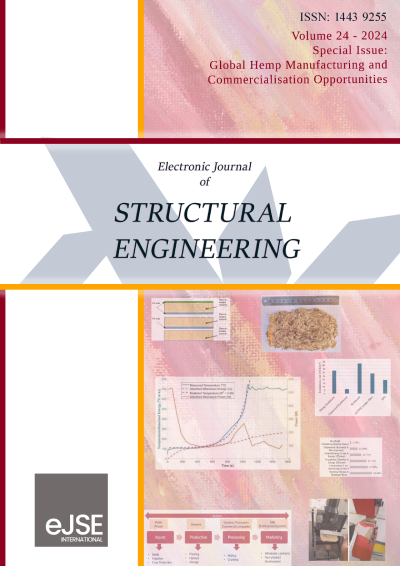Processing of hemp and cannabis residue into non-adhesive chipboards and wall panels
DOI:
https://doi.org/10.56748/ejse.24535Keywords:
Plasma, Hemp, surplus agriculture materials, Constructive boardsAbstract
As woods are dwindling and agriculture waste burning causes severe air pollution and releases greenhouse gases, processing Hemp and lignocellulosic surplus materials into chipboards and other construction elements may substitute timber and reduce environmental pollution. The presented environmental-friendly technology can potentially process hemp and recycle residual materials into industrial woodchip boards and structural elements without the use of hazardous expensive resins. By applying cold plasma pre-treatment followed by the pressing stage acceptable wood chip standard physical properties are achieved. The irradiation dosage is probably optimal since once exceeding the dosage applied, wood disintegration starts; the process improvement may be related to the pressing configuration. Since the pressing temperature and duration are probably higher than required, the element that may still be aligned is the pressing pressure. Moreover, the positive correlation between sample strength and pressing pressure did not reach a steady state value even when pressing the sample to the maximum possible pressure allowed in the existing equipment (5.5 tons). It is suggested that a significant strength improvement will be attained by increasing the pressing pressure and decreasing the pressing temperature. It is assumed that 20 tons/m2 pressing pressure will be sufficient to attain the desired properties.
Downloads
References
We wish to thank Eng. Alexander Gimburg and Yamm Anker for assisting with sample preparation during the first stage. Since the second stage the project is funded by Refael Ezra Clinical Pharmacy LTD.
References
Abuarra, Ali, Rokiah Hashim, Sabar Bauk, Sivamany Kandaiya, and Ehsan Taghizadeh Tousi. 2014. “Fabrication and Characterization of Gum Arabic Bonded Rhizophora Spp. Particleboards.” Materials and Design 60(August 2014):108–15. DOI: https://doi.org/10.1016/j.matdes.2014.03.032
Acda, Menandro N., Edgar E. Devera, Rico J. Cabangon, and Henry J. Ramos. 2012. “Effects of Plasma Modification on Adhesion Properties of Wood.” International Journal of Adhesion and Adhesives 32(1):70–75. DOI: https://doi.org/10.1016/j.ijadhadh.2011.10.003
Akinyemi, Banjo A., Olawale Olamide, and Dada Oluwasogo. 2019. “Formaldehyde Free Particleboards from Wood Chip Wastes Using Glutaraldehyde Modified Cassava Starch as Binder.” Case Studies in Construction Materials 11(April): e00236. DOI: https://doi.org/10.1016/j.cscm.2019.e00236
Ankona, Etty, Victor Multanen, Marina Nisnevitch, Miriam Billig, and Yaakov Anker. 2021. “Investigation of Pyrolysis Kinetics and Gaseous Compounds Emitted during Charcoal Production from Woods Commonly Used in the Eastern Mediterranean.” Biofuels, Bioproducts and Biorefining 2021(1):1–11. DOI: https://doi.org/10.1002/bbb.2188
APA. 2018. ANSI/APA PRS-610.1: Standard for Performance-Rated Structural Insulated Panels in Wall Applications.
BORMASHENKO, Edward, Yelena BORMASHENKO, and Yaakov ANKER. 2021. “METHOD OF PREPARING PLANT-DERIVED MATERIAL.” PCT.
Ciannamea, E. M., J. F. Martucci, P. M. Stefani, and R. A. Ruseckaite. 2012. “Bonding Quality of Chemically Modified Soybean Protein Concentrate-Based Adhesives in Particleboards from Rice Husks.” JAOCS, Journal of the American Oil Chemists’ Society 89(9):1733–41. DOI: https://doi.org/10.1007/s11746-012-2058-2
Humar, Miha, Davor Kržišnik, Boštjan Lesar, Nejc Thaler, Aleš Ugovšek, Klemen Zupančič, and Mojca Žlahtič. 2017. “Thermal Modification of Wax-Impregnated Wood to Enhance Its Physical, Mechanical, and Biological Properties.” Holzforschung 71(1):57–64. DOI: https://doi.org/10.1515/hf-2016-0063
Ira, Jiří, Lucie Hasalová, Vojtěch Šálek, Milan Jahoda, and Václav Vystrčil. 2020. Thermal Analysis and Cone Calorimeter Study of Engineered Wood with an Emphasis on Fire Modelling. Vol. 56. DOI: https://doi.org/10.1007/s10694-019-00922-9
Khosravi, Sara, Farideh Khabbaz, Petra Nordqvist, and Mats Johansson. 2014. “Wheat-Gluten-Based Adhesives for Particle Boards: Effect of Crosslinking Agents.” Macromolecular Materials and Engineering 299(1):116–24. DOI: https://doi.org/10.1002/mame.201300045
Kim, Mimi, Heung Soo Kim, and Joong Yeon Lim. 2013. “Waste Wood Biocomposites.” Polymer 2013. DOI: https://doi.org/10.1155/2013/138083
Lieberman, Roy Nir, Yaakov Anker, Oriol Font, Xavier Querol, Yitzhak Mastai, Yaniv Knop, and Haim Cohen. 2015. “Potential of Hazardous Waste Encapsulation in Concrete Compound Combination with Coal Ash and Quarry Fine Additives.” Environmental Science and Technology. DOI: https://doi.org/10.1021/acs.est.5b03858
Moezzipour, Bita, Ali Abdolkhani, Kazem Doost-hoseini, S. A. Ahmad Ramazani, and Asghar Tarmian. 2018. “Practical Properties and Formaldehyde Emission of Medium Density Fiberboards (MDFs) Recycled by Electrical Method.” European Journal of Wood and Wood Products 76(4):1287–94. DOI: https://doi.org/10.1007/s00107-018-1291-2
Nakanishi, Erika Yukari, Matheus Roberto Cabral, Juliano Fiorelli, André Luís Christoforo, Paulo de Souza Gonçalves, and Holmer Savastano Junior. 2019. “Latex and Rosin Films as Alternative Waterproofing Coatings for 3-Layer Sugarcane-Bamboo-Based Particleboards.” Polymer Testing 75(November 2018):284–90. DOI: https://doi.org/10.1016/j.polymertesting.2019.02.026
Peters, F., B. Hünnekens, S. Wieneke, H. Militz, G. Ohms, and W. Viö. 2017. “Comparison of Three Dielectric Barrier Discharges Regarding Their Physical Characteristics and Influence on the Adhesion Properties on Maple, High Density Fiberboards and Wood Plastic Composite.” Journal of Physics D: Applied Physics 50(47). DOI: https://doi.org/10.1088/1361-6463/aa8fad
Sifuentes-Nieves, Israel, Roberto Yáñez-Macías, Pamela C. Flores-Silva, Pablo Gonzalez-Morones, Carlos A. Gallardo-Vega, Eduardo Ramírez-Vargas, and Ernesto Hernández-Hernández. 2023. “Ultrasound/Plasma-Modified Agave Fibers as Alternative Eco-Sustainable Raw Material to Reinforce Starch-Based Films.” Journal of Polymers and the Environment 31(2):595–607. DOI: https://doi.org/10.1007/s10924-022-02645-5
Wang, Chengyu, and C. Piao. 2011. “From Hydrophilicity to Hydrophobicity: A Critical Review - Part II: Hydrophobic Conversion.” Wood and Fiber Science 43(1):41–56.
Zhao, Xiang fei, Lan qin Peng, Hong ling Wang, Yan bin Wang, and Hong Zhang. 2018. “Environment-Friendly Urea-Oxidized Starch Adhesive with Zero Formaldehyde-Emission.” Carbohydrate Polymers 181(November 2017):1112–18. DOI: https://doi.org/10.1016/j.carbpol.2017.11.035
Downloads
Published
How to Cite
Issue
Section
License
Copyright (c) 2024 Yaakov Anker, Edward Bormashenko, Yelena Bormashenko, Zeev Mor Haim, Yaniv Knop

This work is licensed under a Creative Commons Attribution 4.0 International License.







